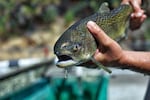
FILE - This August 2017 photo provided by the U.S. Fish and Wildlife Service shows a winter-run Chinook salmon.
Steve Martarano / AP
From dams to drought, salmon face a lot of threats in the West. Add thiamine deficiency to the list. New research sheds light on where salmon could get this vitamin.
Thiamine, also known as vitamin B1, is critical for salmon health. Juvenile fish can die without enough of the nutrient.
Researchers have known salmon’s ocean diet impacts their thiamine levels. Scientists at Oregon State University have called “thiamine deficiency complex” a growing threat. For example, a diet rich in anchovies rather than sardines can lead to a deficiency.
Related: Dwindling Chinook salmon in Oregon river fires up calls for Endangered Species Act designation
But for the first time, scientists have measured the vitamin’s availability in freshwater rivers where the fish deposit eggs.
Christopher Suffridge, a microbiologist at OSU, helped author the recent report that looked at Chinook salmon spawning habitats in California’s Sacramento River. His team found thiamine present in the river and sediment. And they think that could support salmon development.
He says it’s something to consider in salmon restoration efforts.
“We believe that including the microbes that live in the river and in the river gravels is important in understanding what makes a successful spawning habitat,” says Suffridge.
Related: ‘Killing salmon to lose money’: A costly, questionable plan on the Willamette
Several dams are coming down on the Klamath River along the Oregon-California border in 2024 with a goal of restoring salmon populations.
Suffridge says success could also depend on the ecology of the river’s floor where thiamine pools can support newly hatched fish.